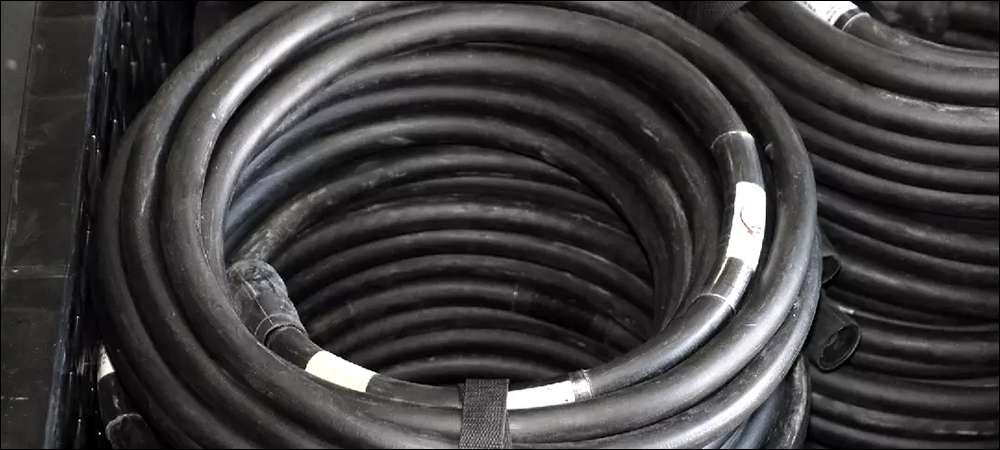- Identifying Each Cable Tangled in a Bin
- Matching Tag Reads with Customer Orders
- Locating Missing Equipment in the Warehouse
- Ensuring Effective Reads Around Metal

Jason Hanis
Power equipment rental company Kwick Power Rentals has deployed a radio frequency identification system that captures data within a matter of minutes about which goods are leaving from and returning to its facility, to provide reliable information regarding every product’s status. With the technology, the company has been able to identify if any items are missing from a returned order, and then accurately bill and notify a customer. The solution, provided by technology company A2B Tracking, consists of ruggedized UHF RFID tags, handheld readers and cloud-based software that manages the data.
Kwick Power Rentals’ equipment is used to test critical power infrastructure at data centers, hospitals or other critical facilities with a complex power system that cannot afford to fail. Business has been growing for power-testing providers, the firm reports. When generators or other equipment are installed in a new building construction, for example, Kwick Power Rentals provides the tools required to test the power system and ensure it operates properly. The company was launched five years ago in Mamaroneck, N.Y., mostly serving Westchester County and the Tri-State area, but also throughout the United States, according to Jason Hanis, Kwick Power Rentals’ president.
For the past two years, Hanis says, Kwick Power Rentals has been leveraging its RFID system to ensure the visibility and accountability of the products it rents to such customers. The company’s clients include builders and electrical contractors involved in the commissioning of new installations to ensure power quality and responsiveness. To accomplish these tests, Kwick Power Rentals provides load banks that put a sample load on the equipment. It also rents out meters and a variety of cables that are used for a week, a month or longer. The firm ships its equipment to and from customers, using its own trucks for local deliveries, and it provides tractor-trailer-size shipments through a third-party carrier.
Identifying Each Cable Tangled in a Bin

David Gardner
The challenge for Kwick Power Rentals has been to ensure all the products sent to customers are returned and accounted for. The equipment can be high in value, Hanis says, including cables, which are often difficult to identify and are frequently lost between the renting and returning processes. Traditionally, companies have faced a daunting challenge when it comes to identifying equipment, such as cables that are often shipped in large bins. In most cases, individuals conduct a count of equipment as it is shipped and again when it is received back. If a discrepancy is discovered, they discuss the problem with their client, who may disagree that an item is missing, or that they were responsible.
Each piece of equipment has a unique serial number, while cables traditionally fell into the “bulk asset” category, meaning they were only counted physically, without being uniquely identified. If 300 cables and cords are returned packed together like “a bowl of spaghetti,” Hanis says, employees must separate, examine and count all of the items. Only after that process is complete can the company go back to the customer to indicate whether all the assets have been returned, or if any are missing. That process can take days to complete.
Each cable can weigh 50 pounds, Hanis says, so identifying the type and counting each cable can require excess heavy lifting and a lot of work to untangle them. The company decided that RFID could provide a solution. By reading all tags within a bin via a handheld reader, he explains, “We could inventory everything almost instantly once it returns.” The company began working with A2B Tracking in 2019, first testing to determine the best UHF RFID tags and ordering them, then tagging assets in 2020, according to David Gardner, A2B Tracking’s solutions marketing manager.
Matching Tag Reads with Customer Orders
Tags were applied to everything except for some small items, such as Ethernet cables and large trailer-mounted items. With the technology in place, the company now uses A2B Tracking’s cloud-based solution from the point at which an order comes in, though some of its existing processes remain. When an order is received, office employees use the A2B Tracking RFID platform to create job numbers linked to the order details, then print the order and hand it to a warehouse worker. They next use a Zebra Technologies RFD8500 handheld reader, tethered via Bluetooth to an Android-based smartphone running an A2B Tracking app.
Workers can view the items on the printed job report, collect the necessary products to fulfill the order, and scan those items, adding them to the order’s grouping. This updates the software to indicate what is “on rent” and links it with the job number, assigning the asset to a customer. Prior to shipping, the items being packed are compared against the order details to confirm no errors have been made. This can be accomplished by quickly scanning the items with the RFD8500 reader, Hanis says, after which the goods are shipped to the customer. Once they are returned, the RFID reads provide one of the system’s key benefits.
The implementation of RFID has not changed the shipping process significantly, Hanis reports, but it has helped to ensure each shipment’s accuracy. Scanning items at checkout can take several minutes, depending on an order’s size. The return process, on the other hand, has been made more efficient by the RFID reader. As bins are unloaded from incoming trucks, workers read the tags in each container (which could hold up to 48 tagged cables) by waving the reader around and above it. The app on the Android device links the tag reads with the order, changing each item displayed on the screen from orange to green once it has been interrogated. Any items not read remain orange.
If the reader captures all of the products, Hanis says, a user can simply press a prompt to check them all in. If any are discovered to be missing, an alert can be issued to management. The received goods can then be returned to the warehouse, and the software lists those items as received and available for rental to other customers. Next, the items undergo a manual inventory process during which employees look for damage, rate the condition and make sure no RFID tags have been ripped off—which never happens, Hanis says, adding, “We’re using some heavy-duty tie wraps.”
Locating Missing Equipment in the Warehouse
The first 48 hours in which a piece of equipment is missing, Hanis says, can be critical for investigation purposes. For that reason, the immediate capture of data about a missing asset can make it possible for the company to locate it. In the past, a missing cable, reported to a customer days after the bin was received, might not have been resolved. “It used to be we were arguing over one cable, but that one cable could [cost] $400,” Hanis states. “Now I have something I can show them. It’s not an argument anymore. I’ll take screenshots from the browser-based website and say, ‘Here, everything’s there except for these items.'”
To audit the equipment onsite, the RFID readers capture a count of all goods within the warehouse. As a result, Hanis reports, general inventories are now faster and more efficient with the technology. Traditionally, it could take a day to conduct a manual inventory count of the entire facility. “Now,” he says, “we take the scanner and put it on ‘inventory’ and walk through the shop.” Thus, a process that once required a full day to complete can now be accomplished in only 10 minutes. Inventory counts are being conducted more often as well, typically every week. Hanis says he regularly hears the familiar sound of the reader beeping from his office, and with audits captured more often, he notes, the data is more accurate.
To monitor maintenance for each cable, Kwick created a custom field in the software related to cable testing. Workers can scan the barcode on the tag, prompting the app to display details about a particular item, to which workers can then make changes. The company also has a quarantine protocol for out-of-service items, and that status can be input and viewed in the software as well. If the company receives a customer request regarding a potential job that will require specific inventory, management can use the A2B Tracking system to view what is available, or what may be returned soon.
Ensuring Effective Reads Around Metal
The solution was designed to be an affordable, commonsense approach to an inventory problem, Gardner says. Since the system includes handheld readers and hardened, ruggedized RFID tags on assets, he adds, along with software-as-a-service, the cost is kept to a minimum, “and allows a small business like this to find an ROI pretty quickly.” There were some obstacles in developing the solution, one of which was ensuring a passive UHF RFID tag could be read accurately in such a crowded and highly metallic environment. “There were some real challenges,” Gardner says, “to finding a tag that works for each item in that environment, with good RFID reads inside that bin.”
The cables are an inch in diameter, Hanis says, with metal strands comprising 80 percent of volume. “So if you have a tag sandwiched in between cables,” he states, “it’s being buried in metal.” To identify the best tag for this environment, Gardner recalls, Kwik Power Rentals sent a large plastic bin full of cables to A2B Tracking’s Rhode Island facility so it could test tags. Numerous RFID tags were tested to determine the right one, he says, and once a tag was identified, “We then sent the bin back and let them test onsite.” The company has declined to name the tag that was selected.
According to the company, the software has been adjusted to meet the application’s unique needs. Initially, A2B Tracking had not developed the software to accommodate a large number of tag IDs for a single order within a grouping. Its software had allowed for an unlimited number of tag reads, Gardner explains, but grouping came with limitations. “We had to blow that number up and make it unlimited,” he says, “so that was a change that made the software better.”
The system is working effectively, Hanis reports, and the company has tagged approximately 3,600 assets to date. “We’re constantly growing our fleet, adding to our equipment,” he says, and more tags are expected to be added as the company grows.
Key Takeaways:
- By capturing RFID data as goods are shipped to and received from customers, Kwick Power Rentals maintains an automated audit record that aids in identifying and billing for missing items.
- The company can conduct general inventory counts on a more frequent basis now, since the process with RFID is faster than a manual count would be, which means inventory data is more accurate and up to date.


